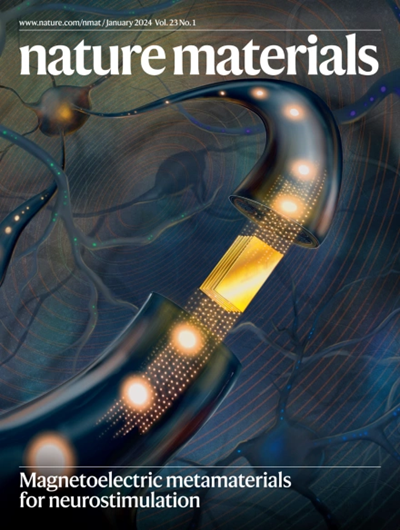化学压电效应在无铅压电陶瓷中的高电应变
IF 37.2
1区 材料科学
Q1 CHEMISTRY, PHYSICAL
引用次数: 0
摘要
压电材料是机电致动器中不可缺少的材料,它需要大的电应变和快速精确的响应。通过设计化学压电效应,我们开发了一种方法,在- 3 kV mm - 1下,在1 Hz下实现1.9%的高电应变,对应于室温下无铅铌酸钾钠压电陶瓷的有效压电系数为>; 6300 pm V - 1。这种电应变具有令人满意的抗疲劳性和热稳定性,以及低迟滞,远远优于现有的铅基和无铅钙钛矿同类产品。通过示踪剂扩散、原子光学发射光谱实验,结合机器学习分子动力学和相场模拟,我们将高电应变归因于交变电场下陶瓷表面氧空位的短程跳变,而样品在低氧分压下退火时,在相同的外加电场下应变水平达到3.0%。这些发现为在缺陷工程的基础上设计材料提供了额外的自由度,这不仅有利于压电材料的电应变,而且有利于更广泛的氧化物基材料的功能特性。本文章由计算机程序翻译,如有差异,请以英文原文为准。


High electrostrain in a lead-free piezoceramic from a chemopiezoelectric effect
Piezoelectric materials are indispensable in electromechanical actuators, which require a large electrostrain with a fast and precise response. By designing a chemopiezoelectric effect, we developed an approach to achieve a high electrostrain of 1.9% under −3 kV mm−1, at 1 Hz, corresponding to an effective piezoelectric coefficient of >6,300 pm V−1 at room temperature in lead-free potassium sodium niobate piezoceramics. This electrostrain has satisfactory fatigue resistance and thermal stability, and low hysteresis, far outperforming existing lead-based and lead-free perovskite counterparts. From tracer diffusion, atomic optical emission spectrometry experiments, combined with machine-learning molecular dynamics and phase-field simulations, we attribute the high electrostrain to short-range hopping of oxygen vacancies near ceramic surfaces under an alternating electric field, which is supported by strain levels reaching 3.0% under the same applied field when the sample was annealed at a low oxygen partial pressure. These findings provide an additional degree of freedom for designing materials on the basis of defect engineering, which will favour not only the electrostrain of piezoelectrics but also the functional properties of a broader range of oxide-based materials. The authors demonstrate a chemopiezoelectric effect in which the displacive migration of oxygen vacancies driven by an electric field induces a large strain in the surface layer of thin (K,Na)NbO3 ceramics. They achieve an electrostrain of 1.9% under a field of −3 kV mm−1, with thermal stability up to 200 °C.
求助全文
通过发布文献求助,成功后即可免费获取论文全文。
去求助
来源期刊

Nature Materials
工程技术-材料科学:综合
CiteScore
62.20
自引率
0.70%
发文量
221
审稿时长
3.2 months
期刊介绍:
Nature Materials is a monthly multi-disciplinary journal aimed at bringing together cutting-edge research across the entire spectrum of materials science and engineering. It covers all applied and fundamental aspects of the synthesis/processing, structure/composition, properties, and performance of materials. The journal recognizes that materials research has an increasing impact on classical disciplines such as physics, chemistry, and biology.
Additionally, Nature Materials provides a forum for the development of a common identity among materials scientists and encourages interdisciplinary collaboration. It takes an integrated and balanced approach to all areas of materials research, fostering the exchange of ideas between scientists involved in different disciplines.
Nature Materials is an invaluable resource for scientists in academia and industry who are active in discovering and developing materials and materials-related concepts. It offers engaging and informative papers of exceptional significance and quality, with the aim of influencing the development of society in the future.
 求助内容:
求助内容: 应助结果提醒方式:
应助结果提醒方式:


